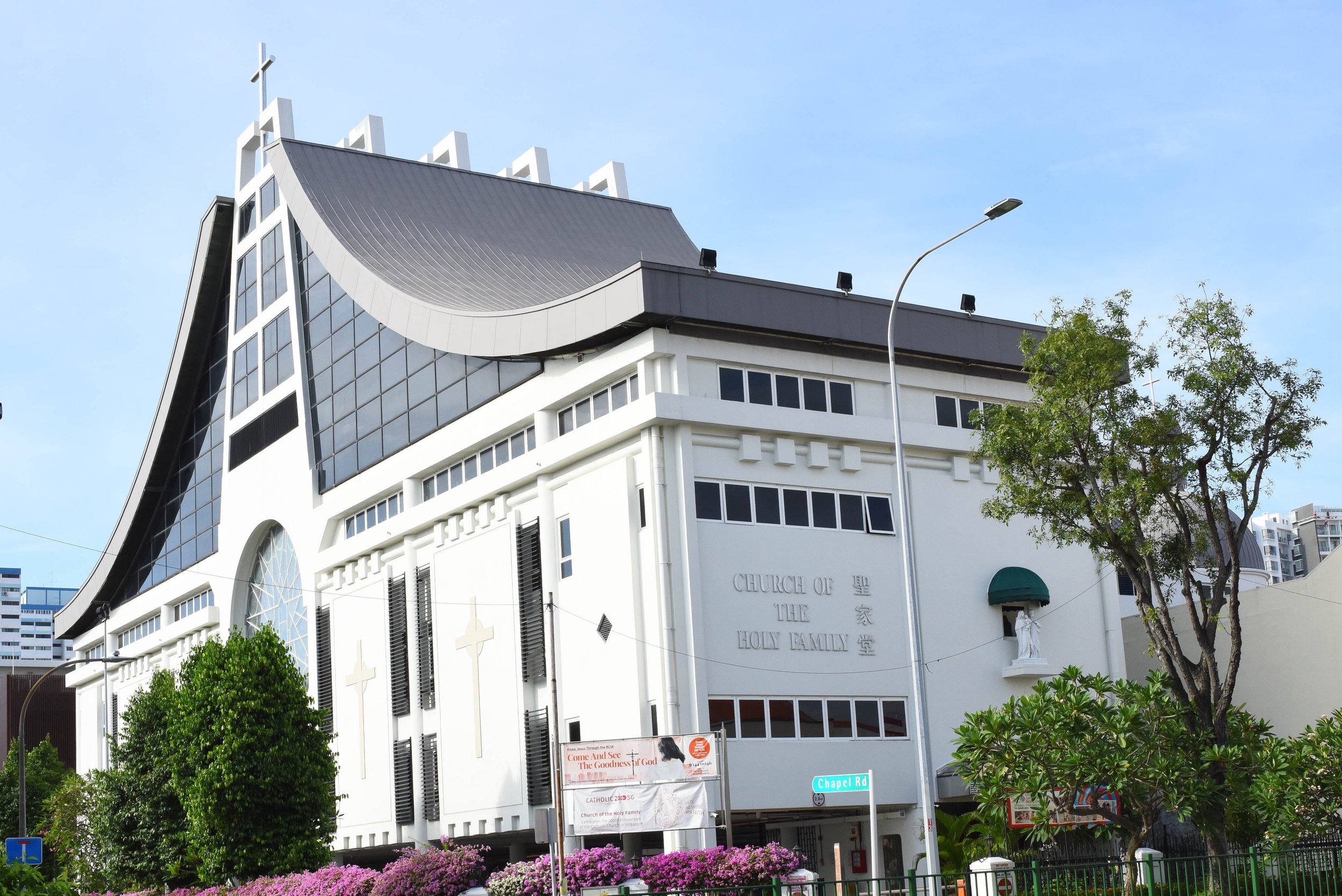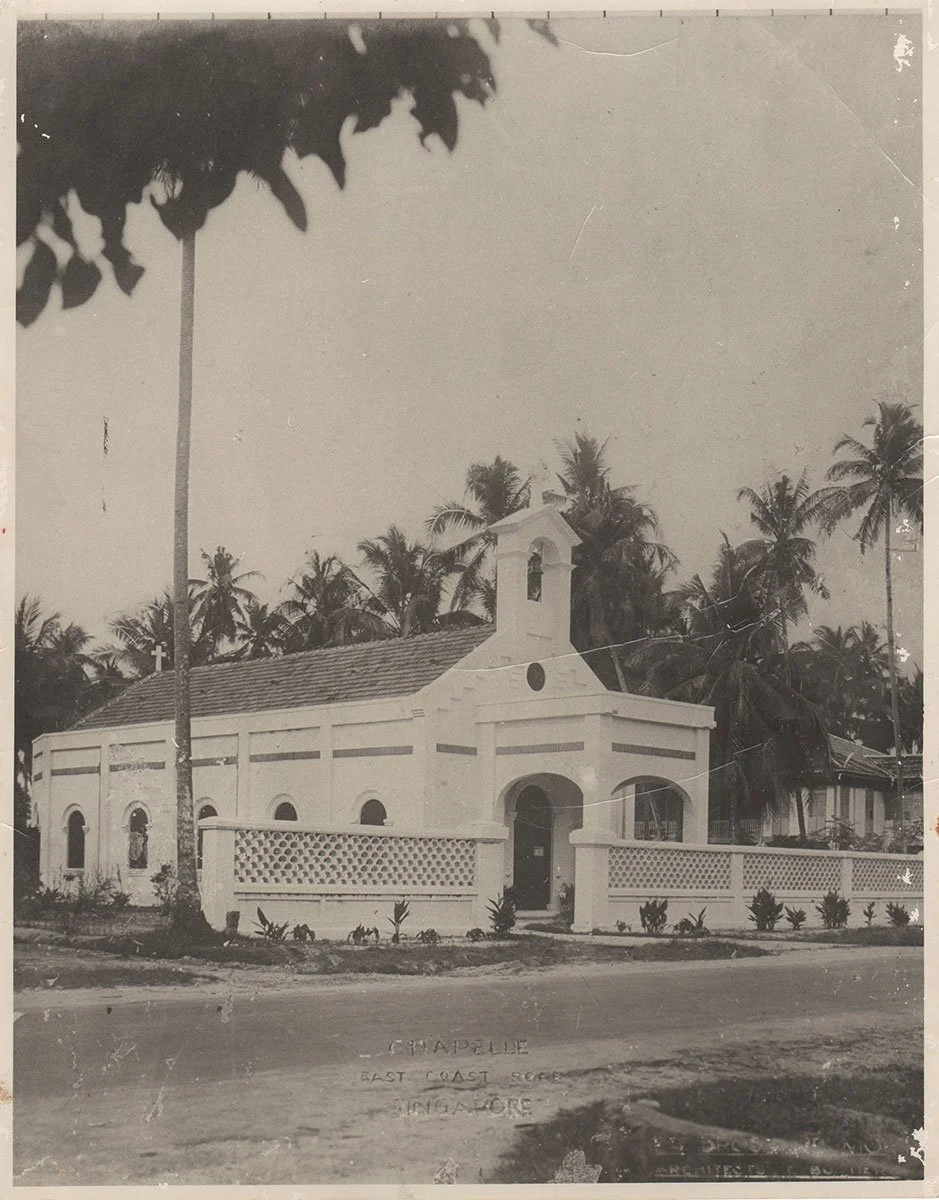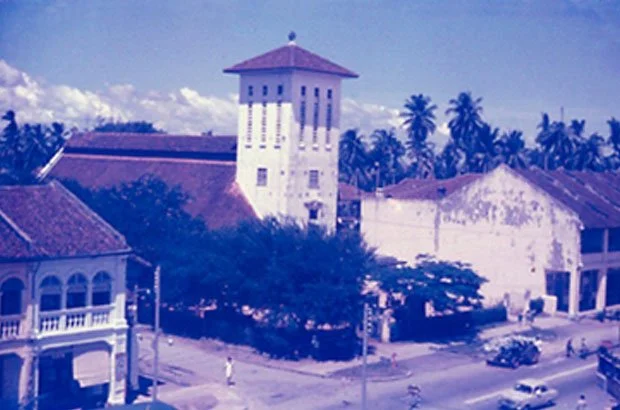
The Katong Church
The Church of the Holy Family stands proudly at the junction of East Coast Road and Chapel Road in Katong, a district renowned for its vibrant Eurasian and Peranakan communities. The church has been a central point for the Roman Catholic community in the East Coast area since its construction in 1932. The church's beginnings were humble, evolving from the prayers of a small group of Eurasian families.
Early Beginnings (1902 - 1923)
The seeds of the Church of the Holy Family were sown in 1902 by four dedicated Eurasian families in Tanjong Katong who desired a local place to worship. Initially, Mass was celebrated in buildings owned by these families along the East Coast, marking the humble beginnings of the parish. Before a formal church was built, a handful of these Eurasian families would gather for prayers at the residence of the De La Salle Brothers. The Brothers lived in timber buildings in Katong (on the site later occupied by St Patrick's School) during their holidays. One of these buildings was used as a makeshift chapel.
The First Chapel (1923 - 1932)
The need for a more permanent structure led to the next phase of development after World War I. In 1922, plans for the new chapel building were ready, and the foundation stone was laid and blessed by the Right Reverend (Rt. Rev.) Marie-Luc-Alphonse-Emile Barillon, Bishop of Malacca. Reverend Father (Rev. Fr.) Pierre Ruaudel, then the parish priest for the Cathedral of the Good Shepherd at Queen Street, spearheaded the effort, securing a plot of land through a generous donation from Mr. James Leonard Scheerder.
The small chapel was subsequently completed and solemnly consecrated to the Holy Family by Rt. Rev. Emile Barillon on 11 November 1923. Upon Scheerder's request, it was named the Chapel of the Holy Family, becoming a vibrant focal point for the Eurasian and Peranakan communities in Katong. The presence of good schools and the chapel attracted many Roman Catholics to the area, leading to sustained population growth.
Building the Church (1931 - 1936)
By the late 1920s and early 1930s, the growing Catholic community had outgrown the small chapel. Consequently, the building was closed on 23 August 1931 and subsequently demolished. While awaiting the construction of a new church building, the community held their Sunday Mass in Arcadia Cinema, the first cinema hall in Katong and the predecessor of the Roxy Cinema (now Roxy Square). The full-sized Church of the Holy Family, also known as Katong Catholic Church, was eventually completed on 19 June 1932. It was blessed by the Rt. Rev. Pierre-Louis Perrichon, Coadjutor Bishop of Malacca, on the same day.
In 1936, the church was officially made a parish by the Rt. Rev. Perrichon, with its first parish priest being Rev. Fr. Pierre Ruaudel, appointed on 25 April 1936. The first Christmas midnight Mass was celebrated in the church on 24 December that year.
The chapel built in Katong which gave rise to the name of Chapel Road.
To further accommodate the growing congregation at Holy Family, the church underwent renovation and extension work in 1969, completed by April 1970. The renovated church hall featured a single large crucifix on a blank wall behind the altar, often decorated for liturgical themes. Notably, David Saul Marshall donated a piece of land to the church, which, arriving too late for the extension, was used as a car park.
By the 1990s, the single-storey church with its distinctive belfry was again insufficient for the increasing number of worshippers. Consequently, it was demolished on 29 December 1997 to make way for a larger building, a project led by the then parish priest, Rev. Fr. Anthony Ho.
Growth and Expansion (1937 - 1997)
The old Church of the Holy Family built in Jun 1932.
The sanctuary of the old Church of the Holy Family.
A New Millennium and Beyond (1997 - Present)
During the two years of reconstruction (1997-1999), Sunday Masses were celebrated in the main hall of Saint Patrick's School, while weekday Masses were held in the school chapel. The new, four-storey church was officially opened and consecrated on 26 December 1999, just prior to the start of the second millennium.
The modern church features 16-panelled stained glass depicting the Holy Family and sixteen scenes from the life of Jesus as the sanctuary’s centerpiece, a two-storey church hall, accommodating approximately 3,000 people, an Adoration Room, Our Lady's Grotto, a 2,500-niche air-conditioned columbarium and a car park. The roof is shaped to resemble hands in prayer.
By 2014, the parish had a diverse community including overseas parishioners. The year 2016 marked the parish's 80th anniversary, celebrated with events and the launch of a commemorative book, From Stones to Living Stones.
Beyond the main church building, the parish compound also includes the Pastoral Centre (formerly the Fathers' House, rebuilt and opened in late 2020), the Emmaus House, and the Church office (formerly a building at 3 Sea Avenue, rebuilt in 2018). The Katong Catholic Shop (formerly Katong Catholic Book Centre) is also located within the church compound.
The Church of the Holy Family as seen from East Coast Road.
An aerial view of the new Church of the Holy Family.
"The Rose Radiant," a stunning 16-panel stained glass designed by Joel Mone and crafted by Saint-Georges in Lyon, France.
The Adoration Room, a space for quiet prayer and reflection in the Presence of the Blessed Sacrament.
The Pastoral Centre, a hub for parish activities.
References
Church of the Holy Family. History of the Catholic Church in Singapore. (n.d.-b). https://history.catholic.sg/church-of-the-holy-family/
Mah, S., Hio, L., & Lee, J. (2021). From Outpost to Church: Singapore’s Catholic Journey 1821-2021. The Titular Roman Catholic Archbishop of Singapore.
National Library Board (2019). Church of the Holy Family. Nlb.gov.sg. https://www.nlb.gov.sg/main/article-detail?cmsuuid=354bd80e-2c77-4437-910b-efd9da2d2467








